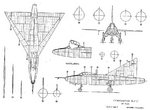kool kitty89
Senior Master Sergeant
Meteor:
First jet with pressurised cockpit
First jet to be flown with four distinct kinds of engines within the space of 2 years.
Axial flow jet - Metro-Vick 1943 (9 axial, 2 turbine, cannular combustor)
Single sided centrifugal jet - 1943 DH Goblin
Double sided centrifugals - Whittle/RR 1943, 1944
Turboprop - RR 1945
Steven
I think the reverse flow Wellands and the straight through Derwents is distinct enough, and '43-45 could be 3 years, but assuming the dates match up that's 5 distinct types.
Let's see, the He 280 was tested with
-HeS-8's centrifugal compressor, annular combustor, along with a radial inflow turbine. (rather uncommon, except in some modern turboshaft and some plant power generators, maybe some turbochargers, I don't think it was ever used again for jets, or not even turboprops)
-Jumo 004A axial flow with can combustors.
-BMW 003 Axial flow with annular combustor.
-Argus As 014 pulsejets.
But either way that's kind of an odd first, though with all the test bed work the Meteor had done over the years, it has probably been tested with the most engines of any a/c. (and set a record for climb with Sapphire engines) I think it's used, Goblins, Welland, Metrovic F.2, Derwent I, Derwent V, MetroVic F.2/4 Beryl, Nene, Avon, Sapphire, Rolls-Royce Soar mini-jet. Probably others.



